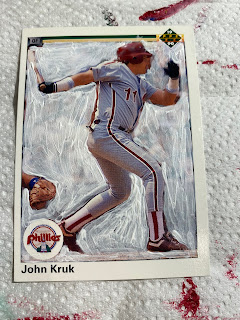As I prepare my talk to the SABR Babe Ruth Chapter this week, this seems like a good time to share the process that I use to create my card paintings. I'm starting to learn more about the community of people who create card art (thanks to Jason Schwartz and others, from SABR's Baseball Cards Research Committee). Anyone's creative process is always changing, so please comment below with any thoughts, suggestions, or questions!
The Underlying Art: Card Selection
I started my paintings with my personal collection, which has some cards from as early as 1987that I began collecting in high school and have stayed with me through college, grad school, and multiple house moves. I have quite a few from the 1988, 1989, and 1990 Donruss sets that I picked up from dime stores more recently, and have also found good examples on eBay and at my favorite card store, Collector's World. (The latter two are especially good resources for 1960s and 1970's cards for the Senators and Orioles). I try not to spend more than a dollar per card. Sometimes I'm interested in particular players, but often more it's about he nature of the player's pose on the card.
Different vintage cards hold the acrylic paints I use differently, Older cards -- through about 1989 or 1990, tend to be printed on traditional card stock, with a glossy side on the front and basic, two color printing on the back. Beginning in the 1990's, though, many cards are glossy on both sides. Lately, I've been getting more into the 1990 Upper Deck set. This example is John Kruk, from his first year with the Phillies.
Preparing the Card
Acrylic paints are somewhat transparent so if the intent is to fully mask the background, it's necessary to mask it. To do this, I use gesso, generally two layers but one is OK if you don't mind some of the background remaining visible under your painting. I use a fine brush so that I can mask the background usually, but you can apply the same technique anywhere on the card. Sometimes I will mask only the background, and sometimes some of the other visual elements on the card. Here, you can see what the Upper Deck card looks like after each coat.
Painting the Card
I often choose colors that are opposite the color wheel from the main color elements in the player's uniform. On this card, the Phillies' uniforms of that era had a lot of maroon features, so I used shades of blue and some pinks as an accent. The aim is to create color fields that show motion, which I like because often the pictures on the cards were made with high-speed cameras that tend to capture a frozen pose. Baseball is a game of movement, so I like to try to capture that.
Once the card is dry (generally overnight), I photograph it for the blog and put it in an acid-free sleeve.
All of my cards aren't the same; other themes that I am exploring include cards with landscapes (often with fall foliage), and paintings that take some of the themes of Russian iconography like golden backgrounds and halos. Please check out the pages here and here that show more of my work.
Thanks so much for looking and for your comments!




Comments
Post a Comment